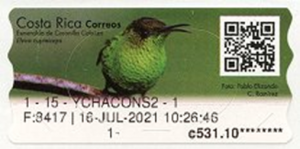The Bird Stamps: Destinations in Belgium
(Written by a former member of the BSS)
The first BE-1 bird stamps issued by TBC-Post featured the Canada Goose (Branta canadensis) which were issued under the title “Wild Geese” [Wilde Ganzen/Oies Sauvages]. In this issue, TBC-Post printed a single stamp design for each individual value (BE-1, BE-2 and BE-3). This approach contrast with later issues that we have already seen, where the EU-1 values were based on 10 different photographs of the African Penguin; and the EU-3 stamps, where there were five birds (two stamps each).
TBC-Post issued these stamps in sheets of ten: BE-1 Wild Goose: 7 November 2012. TBC-Post issued the BE-1 stamp at a price of €0.65. Today, the cost is €1.60.
BE-2 featured Wild Geese: 7 November 2011, and was priced at €1.30, i.e., twice the BE-1 value. Today, the BE-2 tariff is €3.20. Alongside the three separate sheets, TBC-Post also issued – for individual sale – a First Day Postcard which featured a larger photograph of each stamp design:





